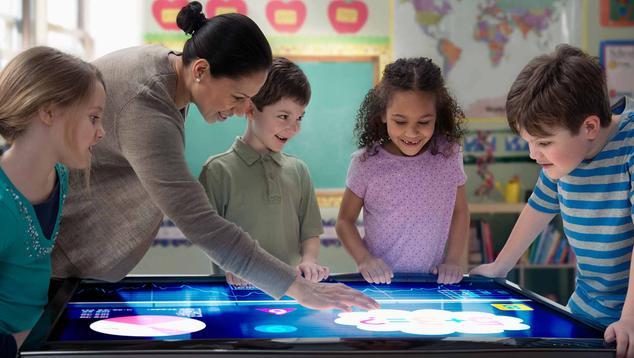Story Highlights
- Digital learning tools have become integral to teaching and learning
- They are effective for a broad range of learning activities
- Educators still need more information about digital learning tools
Americans are increasingly incorporating technology and digital tools into their lives. According to the U.S. Census Bureau, 89% of households in 2016 had a computer (up from 79% in 2015). The swift adoption of new technology has catalyzed the development of new tools to address individuals' and organizations' digital demands, and these demands have decidedly extended into the education space.
There is growing attention around the effective use of education technology to support students' access to transformative learning opportunities in school. Digital learning tools play an increasingly critical role in innovative programs and practices that support students' access to activities and information that help them prepare for future life and work. Considering the experiences and perspectives of those who select, purchase and use digital learning tools can inform the development and integration of new tools that best support teaching and learning in schools.
A new report by Gallup and NewSchools Venture Fund -- Education Technology Use in Schools: Student and Educator Perspectives -- shows that nearly nine in 10 students (89%) say they use digital learning tools to learn at school at least a few days a week, and about seven in 10 (71%) say they use them that often outside of school to get schoolwork done.
Some students want to expand on their already robust usage of digital learning tools. Forty-two percent of students would like to use digital learning tools at school more often; half would like to use them about as often as they use them now, and far fewer (8%) say they would like to use them less often. About one-third of students (34%) say they would like to use them more often outside of school.
| Every day | A few days a week | About once a week | Less than once a week | Never | |||||||||||||||||||||||||||||||||||||||||||||||||||||||||||||||||||||||||||||||||||||||||||||||
|---|---|---|---|---|---|---|---|---|---|---|---|---|---|---|---|---|---|---|---|---|---|---|---|---|---|---|---|---|---|---|---|---|---|---|---|---|---|---|---|---|---|---|---|---|---|---|---|---|---|---|---|---|---|---|---|---|---|---|---|---|---|---|---|---|---|---|---|---|---|---|---|---|---|---|---|---|---|---|---|---|---|---|---|---|---|---|---|---|---|---|---|---|---|---|---|---|---|---|---|
| % | % | % | % | % | |||||||||||||||||||||||||||||||||||||||||||||||||||||||||||||||||||||||||||||||||||||||||||||||
| At school, how often do you use digital learning tools to learn? | 57 | 32 | 7 | 3 | 0 | ||||||||||||||||||||||||||||||||||||||||||||||||||||||||||||||||||||||||||||||||||||||||||||||
| Outside of school, how often do you use digital learning tools to get schoolwork done? | 38 | 33 | 9 | 12 | 7 | ||||||||||||||||||||||||||||||||||||||||||||||||||||||||||||||||||||||||||||||||||||||||||||||
| Gallup | |||||||||||||||||||||||||||||||||||||||||||||||||||||||||||||||||||||||||||||||||||||||||||||||||||
The new report reflects survey results among students, teachers, principals and district administrators in U.S. public schools. Gallup conducted the online surveys on behalf of NewSchools Venture Fund from Jan. 29 to March 25, 2019. The surveys included questions on a range of topics pertaining to education technology use in schools, including access to and availability of education technology; criteria for selecting and purchasing digital learning tools; perceptions of the value, utility and effectiveness of digital learning tools; and links between education technology use and approaches to teaching and learning in schools.
For this study, digital learning tools are broadly described as websites, apps, online tutorials, online games and videos or programs used to teach and support student learning and schoolwork.
The study results reveal five striking areas of congruence across educator constituencies concerning education technology use and its value in schools.
1. Digital learning tools are integral to teaching and learning.
At least eight in 10 teachers (81%), principals (88%) and administrators (92%) strongly agree or agree that they see great value in using digital learning tools in the classroom now, and slightly more among each group see great value in using them in the future.
Most teachers (85%), principals (96%) and administrators (96%) fully or somewhat support the increased use of digital learning tools in their school -- though more principals (71%) and administrators (75%) fully support increased use than do teachers (53%).
2. Digital learning tools are effective across a broad range of learning activities.
Majorities of educators think digital learning tools are extremely effective or effective across 11 learning activities studied. Namely, most teachers, principals and administrators (90%, 95% and 97%, respectively) say digital learning tools are extremely effective or effective for doing research or information searches. Similarly, most say they are effective for creating projects, reports or presentations (84%, 93% and 92%), and at least eight in 10 among each group say they are extremely effective or effective for providing practice lessons and exercises (83%, 90% and 90%).
At least six in 10 special education teachers say digital learning tools are extremely effective or effective for making rigorous content accessible to students with special needs and/or disabilities (69%), supporting the development of life skills for students with special needs (65%), and encouraging communication and collaboration between students with special needs and their peers in class (60%).

3. Digital learning tools are more effective than non-digital learning tools for connecting learning to future jobs and careers, personalizing instruction and engaging students.
Students' engagement with school and their hope for the future are two important measures of school effectiveness -- and digital learning tools may foster these in students. Educators are most likely to say that digital learning tools are more effective than non-digital learning tools for connecting learning to students' future jobs and careers. More than six in 10 teachers (63%) and more than two-thirds of principals (68%) and administrators (70%) say this. Majorities of teachers (57%), principals (65%) and administrators (73%) think digital learning tools are more effective than non-digital tools for personalizing instruction, and majorities of all three educator groups also say they are more effective for engaging students with school and learning. Smaller percentages of teachers, principals and administrators say digital learning tools are more effective than non-digital tools for managing the classroom (27%, 23% and 25%, respectively) and helping students to learn (30%, 31% and 37%).
| Teachers | Principals | Administrators | |||||||||||||||||||||||||||||||||||||||||||||||||||||||||||||||||||||||||||||||||||||||||||||||||
|---|---|---|---|---|---|---|---|---|---|---|---|---|---|---|---|---|---|---|---|---|---|---|---|---|---|---|---|---|---|---|---|---|---|---|---|---|---|---|---|---|---|---|---|---|---|---|---|---|---|---|---|---|---|---|---|---|---|---|---|---|---|---|---|---|---|---|---|---|---|---|---|---|---|---|---|---|---|---|---|---|---|---|---|---|---|---|---|---|---|---|---|---|---|---|---|---|---|---|---|
| % | % | % | |||||||||||||||||||||||||||||||||||||||||||||||||||||||||||||||||||||||||||||||||||||||||||||||||
| Connecting learning to students' future jobs and careers | 63 | 68 | 70 | ||||||||||||||||||||||||||||||||||||||||||||||||||||||||||||||||||||||||||||||||||||||||||||||||
| Personalizing instruction | 57 | 65 | 73 | ||||||||||||||||||||||||||||||||||||||||||||||||||||||||||||||||||||||||||||||||||||||||||||||||
| Engaging students with school and learning | 52 | 55 | 59 | ||||||||||||||||||||||||||||||||||||||||||||||||||||||||||||||||||||||||||||||||||||||||||||||||
| Communicating with students | 50 | 47 | 56 | ||||||||||||||||||||||||||||||||||||||||||||||||||||||||||||||||||||||||||||||||||||||||||||||||
| Giving students ownership of their learning | 45 | 43 | 54 | ||||||||||||||||||||||||||||||||||||||||||||||||||||||||||||||||||||||||||||||||||||||||||||||||
| Assessing student learning | 40 | 51 | 56 | ||||||||||||||||||||||||||||||||||||||||||||||||||||||||||||||||||||||||||||||||||||||||||||||||
| Helping students to collaborate | 38 | 39 | 57 | ||||||||||||||||||||||||||||||||||||||||||||||||||||||||||||||||||||||||||||||||||||||||||||||||
| Helping students to learn | 30 | 31 | 37 | ||||||||||||||||||||||||||||||||||||||||||||||||||||||||||||||||||||||||||||||||||||||||||||||||
| Managing the classroom | 27 | 23 | 25 | ||||||||||||||||||||||||||||||||||||||||||||||||||||||||||||||||||||||||||||||||||||||||||||||||
| Gallup | |||||||||||||||||||||||||||||||||||||||||||||||||||||||||||||||||||||||||||||||||||||||||||||||||||
4. Majorities of educators believe digital learning tools support content that aligns with state standards or district initiatives.
At least half of all three educator groups say digital learning tools support content that aligns with state standards or district initiatives. In addition, about half of teachers (50%) and principals (52%) say digital tools provide immediate and actionable data on student progress, though fewer administrators (44%) say this. Nearly half of teachers (46%), principals (45%) and administrators (44%) say digital learning tools allow personalized instruction based on students' skill levels.
| Teachers | Principals | Administrators | |||||||||||||||||||||||||||||||||||||||||||||||||||||||||||||||||||||||||||||||||||||||||||||||||
|---|---|---|---|---|---|---|---|---|---|---|---|---|---|---|---|---|---|---|---|---|---|---|---|---|---|---|---|---|---|---|---|---|---|---|---|---|---|---|---|---|---|---|---|---|---|---|---|---|---|---|---|---|---|---|---|---|---|---|---|---|---|---|---|---|---|---|---|---|---|---|---|---|---|---|---|---|---|---|---|---|---|---|---|---|---|---|---|---|---|---|---|---|---|---|---|---|---|---|---|
| % | % | % | |||||||||||||||||||||||||||||||||||||||||||||||||||||||||||||||||||||||||||||||||||||||||||||||||
| Supports content that aligns with state standards or district initiatives | 53 | 51 | 51 | ||||||||||||||||||||||||||||||||||||||||||||||||||||||||||||||||||||||||||||||||||||||||||||||||
| Provides immediate and actionable data on students' progress | 50 | 52 | 44 | ||||||||||||||||||||||||||||||||||||||||||||||||||||||||||||||||||||||||||||||||||||||||||||||||
| Supports content that aligns with Common Core standards | 49 | 43 | 38 | ||||||||||||||||||||||||||||||||||||||||||||||||||||||||||||||||||||||||||||||||||||||||||||||||
| Allows personalized instruction based on students' skill levels | 46 | 45 | 44 | ||||||||||||||||||||||||||||||||||||||||||||||||||||||||||||||||||||||||||||||||||||||||||||||||
| Easy to use | 45 | 37 | 34 | ||||||||||||||||||||||||||||||||||||||||||||||||||||||||||||||||||||||||||||||||||||||||||||||||
| Engages students with school and learning | 44 | 39 | 38 | ||||||||||||||||||||||||||||||||||||||||||||||||||||||||||||||||||||||||||||||||||||||||||||||||
| Assesses students' content mastery | 40 | 42 | 38 | ||||||||||||||||||||||||||||||||||||||||||||||||||||||||||||||||||||||||||||||||||||||||||||||||
| Saves me time | 40 | 34 | 30 | ||||||||||||||||||||||||||||||||||||||||||||||||||||||||||||||||||||||||||||||||||||||||||||||||
| Improves student learning outcomes | 38 | 33 | 33 | ||||||||||||||||||||||||||||||||||||||||||||||||||||||||||||||||||||||||||||||||||||||||||||||||
| Cost effective | 36 | 33 | 32 | ||||||||||||||||||||||||||||||||||||||||||||||||||||||||||||||||||||||||||||||||||||||||||||||||
| Empowers students to direct their own learning | 35 | 30 | 33 | ||||||||||||||||||||||||||||||||||||||||||||||||||||||||||||||||||||||||||||||||||||||||||||||||
| Helps students collaborate with others | 32 | 33 | 44 | ||||||||||||||||||||||||||||||||||||||||||||||||||||||||||||||||||||||||||||||||||||||||||||||||
| Integrates data from other sources | 32 | 32 | 35 | ||||||||||||||||||||||||||||||||||||||||||||||||||||||||||||||||||||||||||||||||||||||||||||||||
| Allows student interaction with teachers | 31 | 31 | 41 | ||||||||||||||||||||||||||||||||||||||||||||||||||||||||||||||||||||||||||||||||||||||||||||||||
| Enables a high degree of teacher control | 25 | 24 | 21 | ||||||||||||||||||||||||||||||||||||||||||||||||||||||||||||||||||||||||||||||||||||||||||||||||
| Saves teachers' time | - | 31 | 26 | ||||||||||||||||||||||||||||||||||||||||||||||||||||||||||||||||||||||||||||||||||||||||||||||||
| Allows [me/leaders] to track schoolwide academic progress | - | 43 | 36 | ||||||||||||||||||||||||||||||||||||||||||||||||||||||||||||||||||||||||||||||||||||||||||||||||
| Gallup | |||||||||||||||||||||||||||||||||||||||||||||||||||||||||||||||||||||||||||||||||||||||||||||||||||
5. Educators say there is some but not a lot of information about the effectiveness of digital learning tools.
While educators think digital tools are effective for many learning activities, they need more information to gauge their effectiveness. Fewer than three in 10 teachers (27%), principals (25%) and administrators (18%) say there is a lot of information available about the effectiveness of the digital learning tools they use. About half of teachers (49%) say they have some information about the learning tools they use in their classroom, while 24% say they have little or no information at all.
Providing Critical Information for Educators, Leaders, Developers and Entrepreneurs
As teaching and learning are always changing, educators are continually researching, selecting, learning, implementing and evaluating new digital tools to help students learn -- and students are embracing them. Nearly all elementary students (96%) say digital learning tools are fun, and most say digital tools help them learn things on their own (91%) and at their own pace (88%). Almost three-fourths of secondary students (71%) say digital learning tools help them learn things on their own, and 64% think they make school more interesting. Educators need concise information to gauge the effectiveness of the digital learning tools available for the subject areas they teach and for the learning activities they prioritize.
The Education Technology Use in Schools: Student and Educator Perspectives report reflects the perspectives of those familiar with the impact of tools on student learning and growth. The study results provide critical information for educators, leaders, developers and entrepreneurs to maximize the effectiveness of digital learning tools that support teaching and learning today. Access the full report to learn more.
Learn more about partnering with Gallup to shape the future of education:
- Collaborate with our team of consultants, researchers and subject matter experts to answer pressing questions and create paths for student success.
- Use Gallup's strengths-based development courses for strategies to create thriving students and schools.
- Help students transform their lives by understanding their strengths and how to leverage them in college and beyond.





